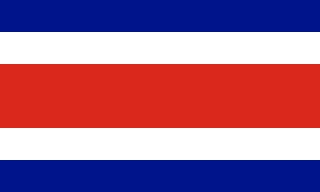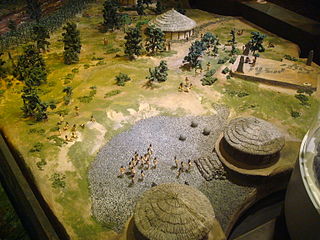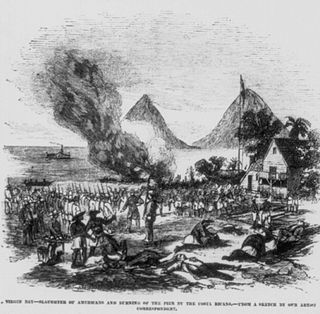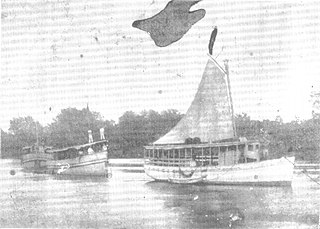
Costa Rica, officially the Republic of Costa Rica, is a country in the Central American region of North America. It borders Nicaragua to the north, the Caribbean Sea to the northeast, Panama to the southeast, and the Pacific Ocean to the southwest, as well as maritime border with Ecuador to the south of Cocos Island. It has a population of around five million in a land area of nearly 51,180 km2 (19,760 sq mi). An estimated 352,381 people live in the capital and largest city, San José, with around two million people in the surrounding metropolitan area.

The first indigenous peoples of Costa Rica were hunters and gatherers, and when the Spanish conquerors arrived, Costa Rica was divided in two distinct cultural areas due to its geographical location in the Intermediate Area, between Mesoamerican and the Andean cultures, with influences of both cultures.

William Walker was an American physician, lawyer, journalist, and mercenary. In the era of the expansion of the United States, driven by the doctrine of "manifest destiny", Walker organized unauthorized military expeditions into Mexico and Central America with the intention of establishing colonies. Such an enterprise was known at the time as "filibustering".

Rodrigo José Ramón Francisco de Jesús Carazo Odio was a Costa Rican economist and politician who served as the 38th President of Costa Rica from 8 May 1978 to 8 May 1982.

Juan Rafael Mora Porras was President of Costa Rica from 1849 to 1859.

Alajuela is a province of Costa Rica. It is located in the north-central part of the country, bordering Nicaragua to the north. It also borders the provinces of Heredia to the east, San José to the south, Puntarenas to the southwest and Guanacaste to the west. As of 2011, the province had a population of 885,571. Alajuela is composed of 16 cantons, which are divided into 111 districts. It covers an area of 9,757.53 square kilometers.

Guanacaste is a province of Costa Rica located in the northwestern region of the country, along the coast of the Pacific Ocean. It is bordered by Nicaragua to the north, Alajuela Province to the east, and Puntarenas Province to the southeast. It is the most sparsely populated of all the provinces of Costa Rica. The province covers an area of 10,141 square kilometres (3,915 sq mi) and as of 2010, had a population of 354,154, with annual revenue of $2 billion.

Juan Santamaría Rodríguez was a drummer in the Costa Rican army, officially recognized as the national hero of his country for his actions in the 1856 Second Battle of Rivas, in the Filibuster War. He died in the battle carrying a torch he used to light the enemy stronghold on fire, securing a victory for Costa Rica against American mercenary William Walker and his forces. Thirty five years after his death, he began to be idolized and was used as a propaganda tool to inspire Costa Rican nationalism. A national holiday in Costa Rica, Juan Santamaría Day, is held annually on April 11 to commemorate his death.

Liberia is a district and the largest city in the Guanacaste Province of Costa Rica, located 215 kilometres (134 mi) northwest of the national capital, San José. Part of the Liberia canton, it is a major center for the country's tourism industry.

Patricio Rivas was a wealthy liberal Nicaraguan lawyer and politician, member of the Democratic Party, who served as Acting Supreme Director of Nicaragua from June 30, 1839 to July 27, 1839 and from September 21, 1840 to March 4, 1841. Later he served as a president of one of the several competing governments of Nicaragua from October 30, 1855 to June 24, 1857. However, he was merely a puppet president; rule was held by William Walker.

The Second Battle of Rivas occurred on 11 April 1856 between Costa Rican militia under General Juan Rafael Mora Porras and the Nicaraguan forces of American mercenary William Walker. The lesser known First Battle of Rivas took place on the 29 June 1855 between Walker's forces and the forces of the Chamorro government of Nicaragua.

The Filibuster War or Walker affair was a military conflict between filibustering multinational troops stationed in Nicaragua and a coalition of Central American armies. An American mercenary, William Walker, and his small private army were invited to Nicaragua in 1855. He seized control of the country by 1856, but was ousted the following year.

Santa Rosa National Park, is a national park, in Guanacaste Province, northwestern Costa Rica, it was created in 1966 by decree 3694.

Santa Ana is the ninth canton in the San José province of Costa Rica. It is located in the Central Valley. It borders with the Alajuela canton to the north, the Mora canton to the south and west, the Escazú canton to the east, as well as the Belén canton to the north east. As of 2022, the canton has the highest Human Development Index of any region in Costa Rica with a score of 0.871.

La Cruz is a canton in the Guanacaste province of Costa Rica. The head city is in La Cruz district.
Civil Guard of Costa Rica was a gendarmerie type force responsible for both limited national defense and internal security missions.
Events in the year 2013 in Costa Rica.
At the 2011 census, the number of immigrants in Costa Rica totaled about 390,000 individuals, or about 9% of the country's population. Following a considerable drop from 1950 through 1980, immigration to Costa Rica has increased in recent decades.

The Coto War was a conflict between Panama and Costa Rica fought between 21 February and 5 March 1921. The casus belli occurred when a Costa Rican expeditionary force led by Colonel Héctor Zúñiga Mora occupied the town of Pueblo Nuevo de Coto, a hamlet on the banks of the Coto River. At that time the hamlet was in the Alanje district of the Panamanian province of Chiriquí. Zúñiga justified the incursion by the fact that there was no definite border between Costa Rica and Panama. The event ignited nationalism both in Costa Rica and in Panama.

The action of 23 November 1856 was a minor naval engagement during the Filibuster War between the Nicaraguan (Filibusters) schooner Granada and the Costa Rican brig Once de Abril, which took place off San Juan del Sur, Nicaragua.

















